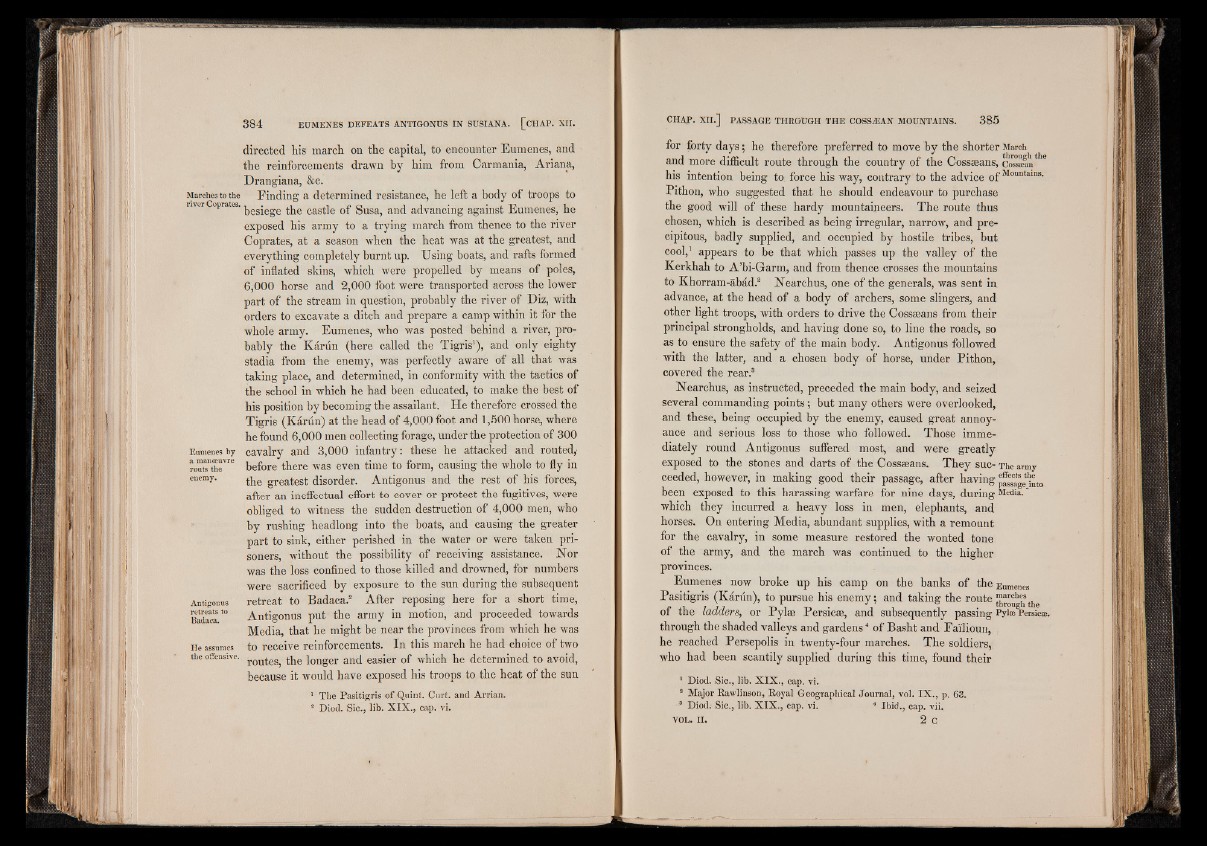
directed his march on the capital, to encounter Eumenes, and
the reinforcements drawn by him from Carmania, Ariana,
Drangiana, &c.
Marches to the Finding a determined resistance, he left a body of troops to
river oprates. ^ e g j e g e c a s t ] e 0f S US£l) and advancing against Eumenes, he
exposed his army to a trying march from thence to the river
Coprates, at a season when the heat was at the greatest, and
everything completely burnt up. Using boats, and rafts formed
of inflated skins, which were propelled by means of poles,
6,000 horse and 2,000 foot were transported across the lower
part of the stream in question, probably the river of Diz, with
orders to excavate a ditch and prepare a camp within it for the
whole army. Eumenes, who was posted behind a river, probably
the Karun (here called the Tigris1), and only eighty
stadia from the enemy, was perfectly aware of all that was
taking place, and determined, in conformity with the tactics of
the school in which he had been educated, to make the best of
his position by becoming the assailant. He therefore crossed the
Tigris (Karun) at the head of 4,000 foot and 1,500 horse, where
he found 6,000 men collecting forage, under the protection of 300
cavalry and 3,000 infantry: these he attacked and routed,'
before there was even time to form, causing the whole to fly in
the greatest disorder. Antigonus and the rest of his forces,
after an ineffectual effort to cover or protect the fugitives, were
obliged to witness the sudden destruction of 4,000 men, who
by rushing headlong into the boats, and causing the greater
part to sink, either perished in the water or were taken prisoners,
without the possibility of receiving assistance. Nor
was the loss confined to those killed and drowned, for numbers
were sacrificed by exposure to the sun during the subsequent
retreat to Badaca.2 After reposing here for a short time,
Antigonus put the army in motion, and proceeded towards
Media, that he might be near the provinces from which he was
to receive reinforcements. In this march he had choice of two
routes, the longer and easier of which he determined to avoid,
because it would have exposed his troops to the heat of the sun
1 The Pasitigris of Quint. Curt, and Arrian.
2 Diod. Sic., lib. X IX ., cap. vi.
Eumenes by
a manoeuvre
routs the
enemy.
Antigonus
retreats to
Badaca.
He assumes
the offensive,
for forty days; he therefore preferred to move by the shorter March
and more difficult route through the country of the Cossaeans, cossseaV 6
his intention being to force his way, contrary to the advice 0f Mountams-
Pithon, who suggested that he should endeavour to purchase
the good will of these hardy mountaineers. The route thus
chosen, which is described as being irregular, narrow, and precipitous,
badly supplied, and occupied by hostile tribes, but
cool,1 appears to be that which passes up the valley of the
Kerkhah to A ’bi-Garm, and from thence crosses the mountains
to Khorram-abad.2 Nearchus, one of the generals, was sent in
advance, at the head of a body of archers, some slingers, and
other light troops, with orders to drive the Cossaeans from their
principal strongholds, and having done so, to line the roads, so
as to ensure the safety of the main body. Antigonus followed
with the latter, and a chosen body of horse, under Pithon,
covered the rear.3
Nearchus, as instructed, preceded the main body, and seized
several commanding points; but many others were overlooked,
and these, being occupied by the enemy, caused great annoyance
and serious loss to those who followed. Those immediately
round Antigonus suffered most, and were greatly
exposed to the stones and darts of the Cossaeans. They sue- The army
ceeded, however, in making good their passage, after having
been exposed to this harassing warfare for nine days, during Media-'
which they incurred a heavy loss in men, elephants, and
horses. On entering Media, abundant supplies, with a remount
for the cavalry, in some measure restored the wonted tone
of the army, and the march was continued to the higher
provinces.
Eumenes now broke up his camp on the banks of the Eumenes
Pasitigris (Karun), to pursue his enemy; and taking the route trough the
of the ladders, or Pylse Persicae, and subsequently passing Pyi® Persic®,
through the shaded valleys and gardens4 of Basht and Failioun,
he reached Persepolis in twenty-four marches. The soldiers,
who had been scantily supplied during this time, found their
1 Diod. Sic., lib. X IX ., cap. -vi.
a Major Rawlinson, Royal Geographical Journal, vol. IX ., p. 63.
3 Diod. Sic., lib. X IX ., cap. vi. 4 Ibid., cap. vii.
VOL. I I . 2 C